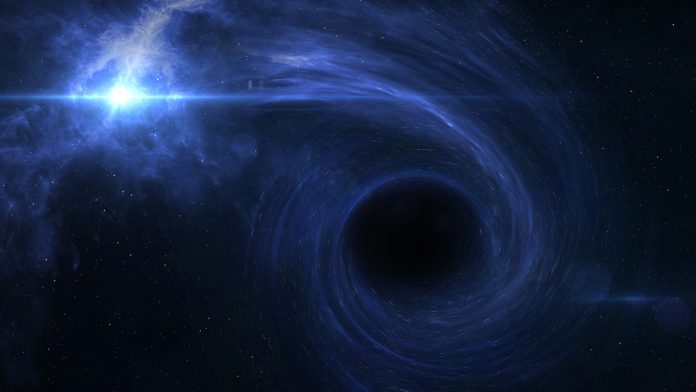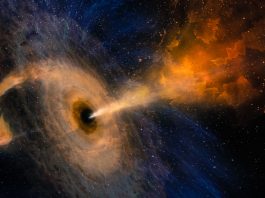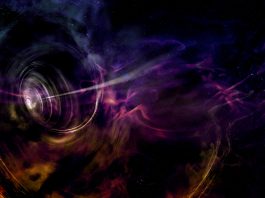Observing two black holes colliding has provided astronomers with a novel tool to measure black holes in distant galaxies.
How did researchers observe these two black holes colliding?
The Columbia University scientists devised a potentially more straightforward way of studying black holes. Outlined in complementary studies in Physical Review Letters and Physical Review D, their imaging technique could allow astronomers to study black holes smaller than M87’s – which has a mass of 6.5 billion suns – harboured in galaxies more distant than M87; at 55 million light-years away, this is still relatively close to the Milky Way.
Their technique has just two requirements. First, a pair of supermassive black holes in the throes of merging is required. Second, the two black holes colliding should be observed at a nearly side-on angle. From this vantage point, as one black hole passes in front of the other, a bright flash of light should occur as the glowing ring of the black hole farther away is magnified by the black hole closest to the observer, a phenomenon known as gravitational lensing.
What is the lensing effect?
The lensing effect is well known, however, researchers have discovered a hidden signal: a distinctive dip in brightness corresponding to the ‘shadow’ of the black hole in the back. This subtle dimming can last from a few hours to a few days; this depends on the size of the black holes and how closely entwined their orbits are.
“If you measure how long the dip lasts, you can estimate the size and shape of the shadow cast by the black hole’s event horizon, the point of no exit, where nothing escapes, not even light,” explained the researchers.
“It took years and a massive effort by dozens of scientists to make that high-resolution image of the M87 black holes,” said Jordy Davelaar, first author of the study, a Postdoc at Columbia and from the Flatiron Institute’s Center for Computational Astrophysics. “That approach only works for the biggest and closest black holes—the pair at the heart of M87 and potentially our own Milky Way.
“With our technique, you measure the brightness of the black holes over time; you do not need to resolve each object spatially. It should be possible to find this signal in many galaxies.”
What does the shadow reveal?
The shadow of a black hole is considered the most mysterious and informative feature. “That dark spot tells us about the size of the black hole, the shape of the space-time around it, and how matter falls into the black hole near its horizon,” noted Zoltan Haiman, a co-author of the study and a physics professor at Columbia.
Additionally, black hole shadows may also hold the secret to the true nature of gravity, one of the fundamental forces of our Universe. Einstein’s theory of gravity, known as general relativity, predicts the size of black holes. Physicists, therefore, have sought them out to test alternative theories of gravity to reconcile two competing ideas of how nature works: Einstein’s general relativity – which explains large scale phenomena like orbiting planets and the expanding Universe – and quantum physics, which describes how tiny particles like electrons and photons can occupy multiple states at once.
What was discovered from observing a suspected pair of supermassive black holes?
After spotting a suspected pair of supermassive black holes, researchers became interested in flaring supermassive black holes at the centre of a far-off galaxy in the early Universe. NASA’s planet-hunting Kepler Space Telescope scanned for the tiny dips in brightness corresponding to a planet passing in front of its host star. Instead, Kepler detected the flares of what Haiman and his colleagues believe to be a pair of merging black holes.
The distant galaxy was named ‘Spikey’ due to the spikes in brightness triggered by what scientists suspected to be black holes magnifying each other on each full rotation via the lensing effect. To learn more about this flare, Haiman built a model with his Postdoc, Davelaar.
However, the researchers were confused when their simulated pair of black holes produced an unexpected but periodic dip in brightness each time one orbited in front of the other. At first, they thought it was a coding mistake; however, further investigations led them to trust the signal.
As they sought a physical mechanism to explain it, they realised that each dip in brightness closely matched the time it took for the black hole closest to the viewer to pass in front of the shadow of the black hole in the back.
How will this dip be explained?
Scientists are currently looking for additional telescope data to confirm the dip they observed in the Kepler data, to verify that Spikey is harbouring a pair of merging black holes. If this proves to be successful, the technique could be applied to a handful of other suspected pairs of merging supermassive black holes among the 150 spotted so far, which are awaiting confirmation.
As more powerful telescopes come online in the coming years, other opportunities may arise. The Vera Rubin Observatory, which is set to open this year, has its sights on more than 100 million supermassive black holes. Further black hole scouting will be possible when NASA’s gravitational wave detector, LISA, is launched into space in 2030.
“Even if only a tiny fraction of these black hole binaries has the right conditions to measure our proposed effect, we could find many of these black hole dips,” Davelaar concluded.









